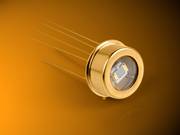 Laser Components
Laser Components
PbSe Detectors

Polycrystalline lead selenide (PbSe) is a standard semiconductor detector with a sensitivity of between 1 µm and 5.2 µm.
The resistance of photoconductive detectors depends on the incident light. PbSe has a particularly strong inner photoelectric effect: When infrared light reaches the lead selenide detector, the resistance is reduced. The detectors can be used uncooled at a wavelength of up to 4.7 µm. At room temperature, they exhibit a detectivity D* of greater than 1010. At low temperatures, they achieve an even higher performance level; in addition, the wavelength shifts to 5.2 µm.
PbSe photodetectors feature a good price-to-performance ratio at a high sensitivity and a good time constant.
PbSe detectors react very quickly and are thus particularly well suited for high-speed applications, such as, for example, the detection of hot spots. They are also used in medical gas analysis (CO2 measurements), emissions measurements in the industrial field and the automobile industry, and in the measurement of moisture and hydrocarbons.
Lead selenide detectors are manufactured by the Laser Components Detector Group in the U.S.A. (i.e., in Tempe, Arizona). The standard size of PbSe chips is 2 mm x 2 mm for all detector models. Other dimensions are available upon request.
PB45 is the uncooled series that detects radiation with a wavelength of between 1 µm and 4.7 µm.
PB50 refers to lead selenide detectors with Peltier cooling as low as -20°C and -30°C.
In the PB55 series, a Peltier cooling as low as -45°C is integrated.
Datasheets
- PbSe Lead Selenide Infrared Detectors PB45 (PDF, 162.6 KB)
- PbSe Lead Selenide Infrared TE Cooled Detector PB50 (PDF, 83.6 KB)
- PbSe Lead Selenide Infrared TE Ultimate Cooled Detector PB55 (PDF, 83.5 KB)
